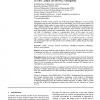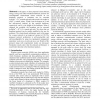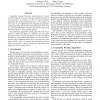718 search results - page 86 / 144 » Energy saving and network performance: a trade-off approach |
IJAHUC
2007
13 years 7 months ago
2007
: In wireless sensor networks, one of the main design challenges is to save severely constrained energy resources and obtain a long system lifetime. Low cost of sensors enables us ...
MOBISYS
2009
ACM
14 years 8 months ago
2009
ACM
Urban sensing, participatory sensing, and user activity recognition can provide rich contextual information for mobile applications such as social networking and location-based se...
MSN
2005
Springer
14 years 1 months ago
2005
Springer
The coverage problem in wireless sensor networks (WSNs) is to determine the number of active sensor nodes needed to cover the sensing area. The purpose is to extend the lifetime of...
IPPS
2007
IEEE
14 years 2 months ago
2007
IEEE
: In this paper, we have proposed a time efficient, energy saving and robust broadcast/multicast protocol for reconfigurable cluster-based sensor network. In our broadcast protocol...
ICWMC
2006
IEEE
14 years 1 months ago
2006
IEEE
Geographic routing in wireless sensor networks is based on the prerequisite that every node has information about its current position, for instance via GPS or some localization a...



